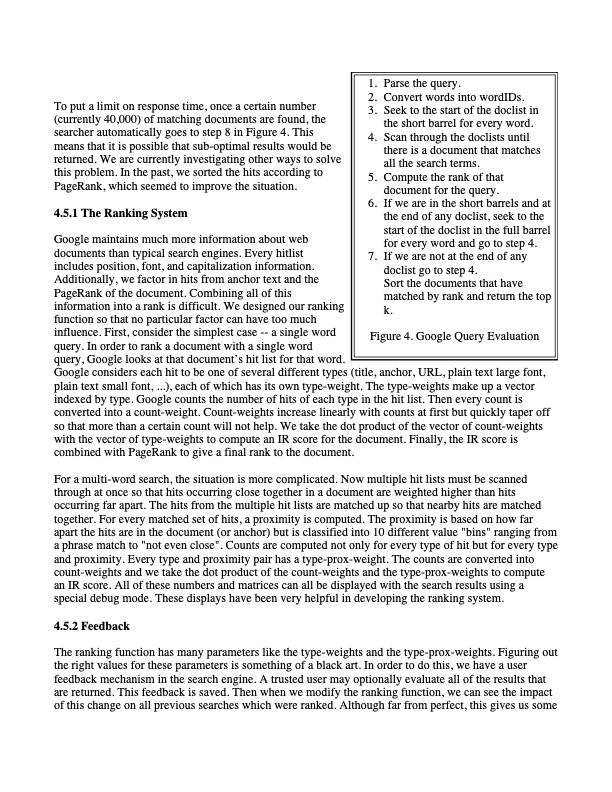
PDF Publication Title:
Text from PDF Page: 012
1. Parse the query. 2. Convert words into wordIDs. 3. Seek to the start of the doclist in the short barrel for every word. 4. Scan through the doclists until there is a document that matches all the search terms. 5. Compute the rank of that document for the query. 6. If we are in the short barrels and at the end of any doclist, seek to the start of the doclist in the full barrel for every word and go to step 4. 7. If we are not at the end of any doclist go to step 4. Sort the documents that have matched by rank and return the top k. Figure 4. Google Query Evaluation To put a limit on response time, once a certain number (currently 40,000) of matching documents are found, the searcher automatically goes to step 8 in Figure 4. This means that it is possible that sub-optimal results would be returned. We are currently investigating other ways to solve this problem. In the past, we sorted the hits according to PageRank, which seemed to improve the situation. 4.5.1 The Ranking System Google maintains much more information about web documents than typical search engines. Every hitlist includes position, font, and capitalization information. Additionally, we factor in hits from anchor text and the PageRank of the document. Combining all of this information into a rank is difficult. We designed our ranking function so that no particular factor can have too much influence. First, consider the simplest case -- a single word query. In order to rank a document with a single word query, Google looks at that document’s hit list for that word. Google considers each hit to be one of several different types (title, anchor, URL, plain text large font, plain text small font, ...), each of which has its own type-weight. The type-weights make up a vector indexed by type. Google counts the number of hits of each type in the hit list. Then every count is converted into a count-weight. Count-weights increase linearly with counts at first but quickly taper off so that more than a certain count will not help. We take the dot product of the vector of count-weights with the vector of type-weights to compute an IR score for the document. Finally, the IR score is combined with PageRank to give a final rank to the document. For a multi-word search, the situation is more complicated. Now multiple hit lists must be scanned through at once so that hits occurring close together in a document are weighted higher than hits occurring far apart. The hits from the multiple hit lists are matched up so that nearby hits are matched together. For every matched set of hits, a proximity is computed. The proximity is based on how far apart the hits are in the document (or anchor) but is classified into 10 different value "bins" ranging from a phrase match to "not even close". Counts are computed not only for every type of hit but for every type and proximity. Every type and proximity pair has a type-prox-weight. The counts are converted into count-weights and we take the dot product of the count-weights and the type-prox-weights to compute an IR score. All of these numbers and matrices can all be displayed with the search results using a special debug mode. These displays have been very helpful in developing the ranking system. 4.5.2 Feedback The ranking function has many parameters like the type-weights and the type-prox-weights. Figuring out the right values for these parameters is something of a black art. In order to do this, we have a user feedback mechanism in the search engine. A trusted user may optionally evaluate all of the results that are returned. This feedback is saved. Then when we modify the ranking function, we can see the impact of this change on all previous searches which were ranked. Although far from perfect, this gives us somePDF Image | natomy of a Large-Scale Hypertextual Web Search Engine

PDF Search Title:
natomy of a Large-Scale Hypertextual Web Search EngineOriginal File Name Searched:
google-anatomy-of-a-search-engine.pdfDIY PDF Search: Google It | Yahoo | Bing
Cruise Ship Reviews | Luxury Resort | Jet | Yacht | and Travel Tech More Info
Cruising Review Topics and Articles More Info
Software based on Filemaker for the travel industry More Info
The Burgenstock Resort: Reviews on CruisingReview website... More Info
Resort Reviews: World Class resorts... More Info
The Riffelalp Resort: Reviews on CruisingReview website... More Info
| CONTACT TEL: 608-238-6001 Email: greg@cruisingreview.com | RSS | AMP |